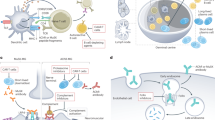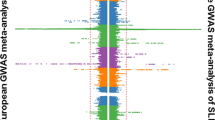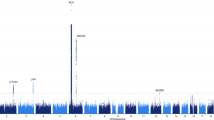Abstract
Autoantibodies against the muscle acetylcholine receptor (AChR) play an essential role in the pathophysiology of autoimmune myasthenia gravis (MG). Their serum titers, however, vary considerably among patients. Our aim was to investigate whether their variation might be explained by genetic factors. Using different methods, we have obtained strong evidence for a three-locus association influencing autoantibody titers in MG patients with thymus hyperplasia or with a normal thymus. Two of the loci, one encoding the AChR α-subunit, the other encoding the α-chain of the class II antigen-presentation molecule, HLA-DQ, demonstrated interaction to determine high autoantibody titers. The third locus was associated with the 8.1 ancestral HLA haplotype. It exerted an additive effect and it is posutlated to have a nonantigen specific immunoregulatory function. Our study demonstrates for the first time that polymorphism of an autoantigen gene may quantitatively modify the immune response against it. Altogether, the data lend support to a three-gene model to explain autoantibody expression in a subset of MG patients.
This is a preview of subscription content, access via your institution
Access options
Subscribe to this journal
Receive 6 digital issues and online access to articles
$119.00 per year
only $19.83 per issue
Buy this article
- Purchase on Springer Link
- Instant access to full article PDF
Prices may be subject to local taxes which are calculated during checkout



Similar content being viewed by others
References
Engel AG . Myasthenia gravis and myasthenic syndromes. Ann Neurol 1984; 16: 519–534.
Drachman DB . Myasthenia gravis. N Engl J Med 1994; 330: 1797–1810.
Vincent A, Palace J, Hilton-Jones D . Myasthenia gravis. Lancet 2001; 357: 2122–2128.
Tzartos SJ, Barkas T, Cung MT et al. Anatomy of the antigenic structure of a large membrane autoantigen, the muscle-type nicotinic acetylcholine receptor. Immunol Rev 1998; 163: 89–120.
Patrick J, Lindstrom J . Autoimmune response to acetylcholine receptor. Science 1973; 180: 871–872.
Lindstrom JM, Seybold ME, Lennon VA, Whittingham S, Duane DD . Antibody to acetylcholine receptor in myasthenia gravis. Prevalence, clinical correlates, and diagnostic value. Neurology 1976; 26: 1054–1059.
Tuzun E, Scott BG, Goluszko E, Higgs S, Christadoss P . Genetic evidence for involvement of classical complement pathway in induction of experimental autoimmune myasthenia gravis. J Immunol 2003; 171: 3847–3854.
Christadoss P . C5 gene influences the development of murine myasthenia gravis. J Immunol 1988; 140: 2589–2592.
De Baets M, Stassen MH . The role of antibodies in myasthenia gravis. J Neurol Sci 2002; 202: 5–11.
Hohlfeld R, Wekerle H . The role of the thymus in myasthenia gravis. Adv Neuroimmunol 1994; 4: 373–386.
Vincent A . Unravelling the pathogenesis of myasthenia gravis. Nat Rev Immunol 2002; 2: 797–804.
Compston DA, Vincent A, Newsom-Davis J, Batchelor JR . Clinical, pathological, HLA antigen and immunological evidence for disease heterogeneity in myasthenia gravis. Brain 1980; 103: 579–601.
Yamamoto AM, Gajdos P, Eymard B et al. Anti-titin antibodies in myasthenia gravis: tight association with thymoma and heterogeneity of nonthymoma patients. Arch Neurol 2001; 58: 885–890.
Garchon HJ . Genetics of autoimmune myasthenia gravis, a model for antibody-mediated autoimmunity in man. J Autoimmun 2003; 21: 105–110.
Dawkins R, Leelayuwat C, Gaudieri S et al. Genomics of the major histocompatibility complex: haplotypes, duplication, retroviruses and disease. Immunol Rev 1999; 167: 275–304.
Willcox N . Myasthenia gravis. Curr Opin Immunol 1993; 5: 910–917.
Giraud M, Beaurain G, Yamamoto AM et al. Linkage of HLA to myasthenia gravis and genetic heterogeneity depending on anti-titin antibodies. Neurology 2001; 57: 1555–1560.
Garchon HJ, Djabiri F, Viard JP, Gajdos P, Bach JF . Involvement of human muscle acetylcholine receptor alpha-subunit gene (CHRNA) in susceptibility to myasthenia gravis. Proc Natl Acad Sci USA 1994; 91: 4668–4672.
Heckmann JM, Morrison KE, Emeryk-Szajewska B et al. Human muscle acetylcholine receptor alpha-subunit gene (CHRNA1) association with autoimmune myasthenia gravis in black, mixed-ancestry and Caucasian subjects. J Autoimmun 1996; 9: 175–180.
Djabiri F, Caillat-Zucman S, Gajdos P et al. Association of the AChRalpha-subunit gene (CHRNA), DQA1*0101, and the DR3 haplotype in myasthenia gravis. Evidence for a three-gene disease model in a subgroup of patients. J Autoimmun 1997; 10: 407–413.
Degli-Esposti MA, Andreas A, Christiansen FT, Schalke B, Albert E, Dawkins RL . An approach to the localization of the susceptibility genes for generalized myasthenia gravis by mapping recombinant ancestral haplotypes. Immunogenetics 1992; 35: 355–364.
Janer M, Cowland A, Picard J et al. A susceptibility region for myasthenia gravis extending into the HLA-class I sector telomeric to HLA-C. Hum Immunol 1999; 60: 909–917.
The MHC Sequencing Consortium. Complete sequence and gene map of a human major histocompatibility complex. Nature 1999; 401: 921–923.
Wells RD . Unusual DNA structures. J Biol Chem 1988; 263: 1095–1098.
Rich A . DNA comes in many forms. Gene 1993; 135: 99–109.
Rothenburg S, Koch-Nolte F, Rich A, Haag F . A polymorphic dinucleotide repeat in the rat nucleolin gene forms Z-DNA and inhibits promoter activity. Proc Natl Acad Sci USA 2001; 98: 8985–8990.
Contente A, Dittmer A, Koch MC, Roth J, Dobbelstein M . A polymorphic microsatellite that mediates induction of PIG3 by p53. Nat Genet 2002; 30: 315–320.
Werlen G, Hausmann B, Naeher D, Palmer E . Signaling life and death in the thymus: timing is everything. Science 2003; 299: 1859–1863.
Derbinski J, Schulte A, Kyewski B, Klein L . Promiscuous gene expression in medullary thymic epithelial cells mirrors the peripheral self. Nat Immunol 2001; 2: 1032–1039.
Wakkach A, Guyon T, Bruand C, Tzartos S, Cohen-Kaminsky S, Berrih-Aknin S . Expression of acetylcholine receptor genes in human thymic epithelial cells: implications for myasthenia gravis. J Immunol 1996; 157: 3752–3760.
Beeson D, Morris A, Vincent A, Newsom-Davis J . The human muscle nicotinic acetylcholine receptor alpha-subunit exist as two isoforms: a novel exon. EMBO J 1990; 9: 2101–2106.
Newland CF, Beeson D, Vincent A, Newsom-Davis J . Functional and non-functional isoforms of the human muscle acetylcholine receptor. J Physiol 1995; 489 (Part 3): 767–778.
Harcourt G, Batocchi AP, Hawke S et al. Detection of alpha-subunit isoforms in human muscle acetylcholine receptor by specific T cells from a myasthenia gravis patient. Proc R Soc London B Biol Sci 1993; 254: 1–6.
Klein L, Klugmann M, Nave KA, Tuohy VK, Kyewski B . Shaping of the autoreactive T-cell repertoire by a splice variant of self protein expressed in thymic epithelial cells. Nat Med 2000; 6: 56–61.
Price P, Witt C, Allcock R et al. The genetic basis for the association of the 8.1 ancestral haplotype (A1, B8, DR3) with multiple immunopathological diseases. Immunol Rev 1999; 167: 257–274.
Mebius RE . Organogenesis of lymphoid tissues. Nat Rev Immunol 2003; 3: 292–303.
Yang H, Goluszko E, David C et al. Mapping myasthenia gravis-associated T cell epitopes on human acetylcholine receptors in HLA transgenic mice. J Clin Invest 2002; 109: 1111–1120.
Voltz R, Hohlfeld R, Fateh-Moghadam A et al. Myasthenia gravis: measurement of anti-AChR autoantibodies using cell line TE671. Neurology 1991; 41: 1836–1838.
Shimosato Y, Mukai K . Tumors of the Mediastinum. Armed Forces Institute of Pathology: Washington, DC, Date: 1997.
Rosai J . Histological Typing of Tumours of the Thymus 2nd edn. Springer: Berlin, 1999.
Udalova IA, Nedospasov SA, Webb GC, Chaplin DD, Turetskaya RL . Highly informative typing of the human TNF locus using six adjacent polymorphic markers. Genomics 1993; 16: 180–186.
Caillat-Zucman S, Garchon HJ, Timsit J et al. Age-dependent HLA genetic heterogeneity of type 1 insulin-dependent diabetes mellitus. J Clin Invest 1992; 90: 2242–2250.
Teutsch SM, Bennetts BH, Castle M, Hibbins M, Heard RN, Stewart GJ . HLA-DQA1 and -DQB1 genotyping by PCR-RFLP, heteroduplex and homoduplex analysis. Eur J Immunogenet 1996; 23: 107–120.
Spielman RS, Mcginnis RE, Ewens WJ . Transmission test for linkage disequilibrium: the insulin gene region and insulin-dependent diabetes mellitus (IDDM). Am J Hum Genet 1993; 52: 506–516.
Kruglyak L, Daly MJ, Reeve-Daly MP, Lander ES . Parametric and nonparametric linkage analysis: a unified multipoint approach. Am J Hum Genet 1996; 58: 1347–1363.
Sham PC, Curtis D . An extended transmission/disequilibrium test (TDT) for multi-allele marker loci. Ann Hum Genet 1995; 59: 323–336.
Acknowledgements
This work was funded by INSERM, the Association Française contre les Myopathies and the Fondation pour la Recherche Médicale. We are most grateful to the participating patients and their families. We thank Dr Charles Bourquin for decisive help with patients recruitment, Ms Catherine Beauvais-Hue for skillful technical assistance, Ms Claire Vandiedonck for critical reading of the manuscript.
Author information
Authors and Affiliations
Corresponding author
Rights and permissions
About this article
Cite this article
Giraud, M., Beaurain, G., Eymard, B. et al. Genetic control of autoantibody expression in autoimmune myasthenia gravis: role of the self-antigen and of HLA-linked loci. Genes Immun 5, 398–404 (2004). https://doi.org/10.1038/sj.gene.6364110
Received:
Revised:
Accepted:
Published:
Issue Date:
DOI: https://doi.org/10.1038/sj.gene.6364110
Keywords
This article is cited by
-
Dysregulation of germinal centres in autoimmune disease
Nature Reviews Immunology (2009)



